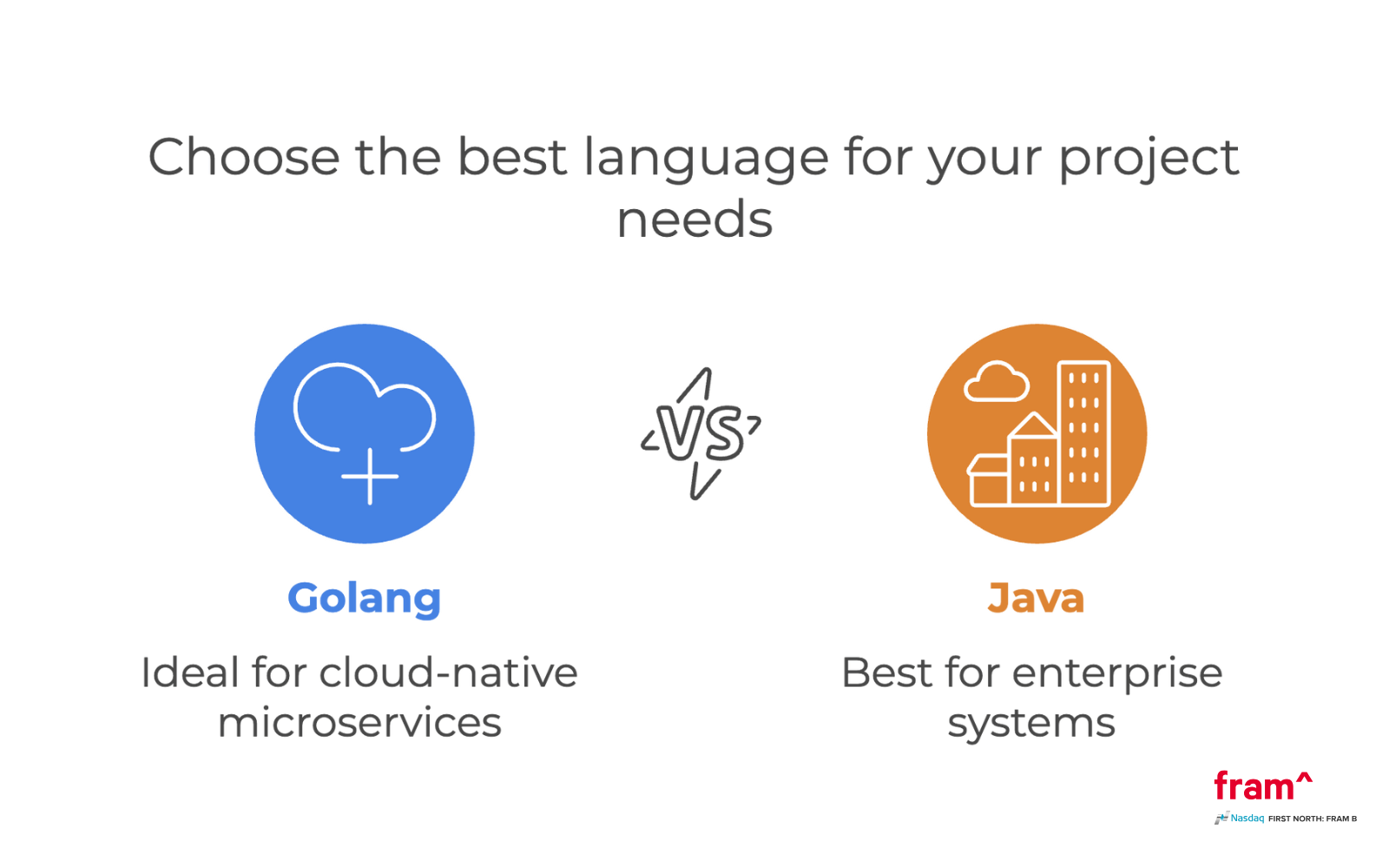Development team
Go vs Java for Microservices: A Developer Comparison
The main difference between Go and Java is that Go focuses on simplicity, lightweight performance, and low memory consumption for cloud-native microservices. Java offers robust enterprise frameworks, extensive libraries, and mature cross-platform capabilities for complex system development.
So, when it comes to building microservices, Golang and Java offer compelling advantages. Each language has carved out its niche in the world of modern software development. This guide will give you a full breakdown of Golang vs Java.
We’ll highlight their unique strengths, weaknesses, and key differences to help you determine the best fit for your next project – whether you’re aiming for speed, scalability, or a cloud-native approach.

Key Takeaways Comparing Golang vs Java
Both Golang (Go) and Java have become popular choices for building microservices. With unique strengths, each language can provide the speed, scalability, and reliability that microservice architectures demand.
Here’s a quick comparison to help identify which language might be the right fit for your project.
|
Comparison Aspect |
Golang |
Java |
|
Syntax |
Simple, minimalist syntax |
Traditional, verbose syntax |
|
Performance |
Excellent for lightweight applications |
Efficient with Just-in-Time (JIT) compilation |
|
Concurrency |
Goroutines provide built-in concurrency |
Thread-based concurrency model |
|
Memory Usage |
Low memory consumption |
Higher memory use, but robust garbage collection |
|
Best for Microservices |
Lightweight, cloud-native microservices |
Enterprise-grade, complex microservices |

What is Golang (Go)?
Golang, or Go, is a modern, compiled programming language designed for speed, simplicity, and scalability.
Created by Google, Go has gained popularity for its efficiency in cloud-native development, system programming, and lightweight mobile apps.
Its rich standard library makes it easy to develop robust applications without relying on extensive external dependencies.
Why Golang is Good for Microservices
Golang’s strengths align well with the needs of microservices, especially in terms of performance, concurrency, and simplicity.
Designed for efficiency and scalability, Go has gained traction for cloud-native applications. Low memory consumption and high-speed performance are essential (check out the various performance tests we like to run for our projects). Its strong community continues to expand the ecosystem, supporting developers in building scalable, secure systems.
Advantages of Using Golang for Microservices
- Fast Execution: Go’s compiled nature enables it to run fast, a critical feature for microservices responding quickly under heavy loads.
- Concurrency Model: Go’s goroutines make handling simultaneous requests efficient and lightweight, making it a strong fit for handling concurrent microservices.
- Low Memory Consumption: Microservices benefit from Go’s low memory usage, which improves server efficiency and reduces hosting costs.
At Fram, we use Golang for building lightweight, high-performance microservices due to its speed and scalability, especially for cloud-based applications (learn all about the pros and cons of cloud computing).
Challenges of Using Golang for Microservices
- Limited Libraries: While Go’s ecosystem is growing, it still lacks the vast library resources available in Java, which can require more time for building complex microservices.
- No Generics (Yet): Go’s lack of generics (coming in future versions) can lead to repetitive code, affecting maintainability in larger microservices applications.
What is Java?
Java is a relatively mature, object-oriented language known for its stability, cross-platform capabilities, and vast ecosystem.
Since 1996, Java has evolved into one of the most popular languages for mobile apps, enterprise systems, and large-scale microservices.
Its extensive features, such as automatic memory management and robust libraries, make it reliable for building secure, scalable applications.
Why Java is Good for Microservices
Java’s robustness and maturity make it a popular choice for complex, large-scale microservices. With frameworks like Spring Boot,
Java is a proven technology in enterprise environments where stability and extensive library support are necessary.
Advantages of Using Java for Microservices
- Established Frameworks: Frameworks like Spring Boot simplify microservice development, providing built-in tools and resources to speed up deployment.
- Cross-Platform Flexibility: Java’s JVM makes it highly portable and ideal for distributed systems that may run on different operating systems.
- Mature Ecosystem: Java’s ecosystem is extensive, with libraries and community support for almost any functionality, which can simplify development for complex microservices.
At Fram, we use Java to develop reliable, scalable enterprise microservices because it provides the necessary stability and tools for complex systems.
Challenges of Using Java for Microservices
- Higher Memory Usage: Java consumes more memory, which can be a drawback for microservices that aim to minimize server resources.
- Slower Startup Times: Java applications may experience slower startup due to JIT compilation, which can impact scaling performance in dynamic environments.
Golang vs Java: Detailed Comparison
Let’s explore the main differences between Golang and Java to get a more complete idea of how they stack up.
Performance
Golang’s compiled nature makes it faster for applications requiring quick response times.
Java, meanwhile, thanks to JIT compilation, is efficient for complex operations in larger-scale systems.
We can confidently say that Go’s popularity is most certainly due to its performance. As a compiled language without a specific runtime environment (e.g., a VM), Go is one of the top-performing languages in both compilation and runtime.
In contrast, Java, following the well-known Built-One-Run-Everywhere philosophy, needs JVM to run the program. This makes it less performant than other compiled languages such as Go,C/C++, and Rust. However, Java is not a low-performance language.
For the past decades, it has been widely used in enterprise systems that handle a huge workload and will continue to be one of the top choices in the years to come.
Simplicity
Simplicity is another one of Go’s design goals. Therefore, Go programs tend to be cleaner, with concise syntax, fewer keywords and punctuation marks, and a minimum type hierarchy, which contributes to runtime performance in one way or another.
On the flip side, Java is commonly criticized for its verbosity. Java syntax is relatively complicated, with many keywords and punctuation marks.
That said, with modern code editors or IDEs, together with code linters, syntax is no longer a big problem for software developers. One can even code without memorizing all the syntax rules, which can be handled by auto code completion or even AI.
Concurrency
Go was designed with concurrency in mind. Therefore, it supports an efficient mechanism for concurrency with Goroutine as a “lightweight thread” and Channel for communication between Goroutines.
With this approach, software developers fall in love with Go in concurrency tasks where the code is simple, clean, and safe.
Java was designed with a thread that represents the OS thread, which means it is more resource intensive, especially when a lot of threads are needed.
Luckily, version 19 of Java supports a “virtual thread,” which is also lightweight and much cheaper than the original thread.
Security
Both Go and Java prioritize security, but their approaches differ.
Go’s simplicity reduces the risk of potential vulnerabilities caused by complex code. The standard library also includes secure packages for cryptography, HTTP handling, and more, making it suitable for secure cloud-native development.
Java, on the other hand, has a long history as an object-oriented language, which means it has undergone decades of security enhancements.
Features like built-in encryption libraries, a robust sandbox model, and a mature JVM make it a trusted choice for enterprise-grade applications requiring high security.
Memory Consumption
Go’s lower memory footprint makes it a better choice for lightweight microservices running on limited server resources.
Java uses more memory, though this is balanced by its robust garbage collection, which can be useful in enterprise-level systems requiring consistent uptime.
Both Go and Java are designed with Garbage Collection for memory management.
Luckily, GC makes life much easier for software developers because they don’t need to care so much about how memory resources are collected and memory leak issues.
Error Handling
Go and Java have completely different ways of handling errors.
Go functions choose to return errors as results instead of throwing “exceptions” to interrupt the code flow.
This approach makes the code clearer.
It is obvious what will happen if an error occurs in a piece of code. This is one of the design goals of Go: trying to make the code as clear as possible with minimum implicit behaviors.
Java (and many other languages) choose to throw exceptions and break the code flow if something goes wrong. This approach makes the code simpler and really focuses on the main flow.
However, sometimes, the error bubbles up to so many levels that it can be shown or logged in a different place, making debugging more costly and time-intensive.

Cloud Native
In the world of microservices and modern software, cloud computing and containerization play key roles in software development. As a result, the software system becomes scalable with minimal time to market (don’t miss our full guide on the pros and cons of cloud computing).
Both Go and Java are supported seamlessly by Cloud services (e.g. AWS Lambda,Azure Function).
For containerization, Go has a bit advantages over Java when it does not require a runtime environment. Go program can be built into a binary executable and executed inside a container. Java program needs to be packed and run inside an appropriate container with pre-installed JVM.
Community And Maturity
By the nature of open-source projects, both Go and Java have a good community backed by big giants, which is really helpful in daily software development.
Google designed Go in 2007 and first released it in 2012. However, it is still a relatively young language compared to others, such as Java or C/C++ – so It has a smaller community than Java.
Nevertheless, Go has many adopters and a rich collection of libraries that can help us solve almost all common problems.
In contrast, Java is one of the good old boys in the programming language family, having been around since 1996.
With such a long history, Java has an awesome community with a vast collection of frameworks to solve most software development problems, especially for the back-end side.
People even say that if a Java question pops up, it is almost certainly already been answered somewhere on the Internet.
Programming Paradigm
There are no clear advantages of one programming paradigm over the other. It is more about personal or organizational taste.
Both of them can do well in terms of solving problems. Some programmers feel more comfortable with OOP, while others prefer functional programming.
Java is fundamentally an object-oriented language focusing on encapsulation, inheritance, and polymorphism. Object-oriented programming (OOP) has become the most popular programming paradigm in recent years, and Java is one of the languages based on that paradigm. Everything in OOP revolves around objects.
On the other hand, Go follows a minimalist approach rooted in functional programming principles, where everything revolves around functions.
Go does support inheritance and interfaces, but not in the same way that Java does. A type satisfies an interface if it implements all functions defined in that interface; no explicit inheritance is needed in Go.
Scalability
Both Go and Java scale well, though Go’s simplicity makes it easy to scale horizontally in cloud-native environments. Java’s extensive frameworks, like Spring Cloud, provide robust tools for scaling complex microservices systems in enterprise settings.
Trends and Future Outlook
Due to its efficiency and simplicity, Golang is rapidly growing as a popular language for microservices, particularly for cloud-native applications.
Java, with its decades-long history and extensive features, remains a staple in enterprise environments. It offers stability and a vast ecosystem.
Both languages are likely to coexist, with Go being preferred for newer, agile microservices architectures and Java holding strong in traditional enterprise applications.
Biggest Differences To Know About Go and Java
While both languages are suitable for microservices, their fundamental differences lie in their design philosophy and use cases.
Golang focuses on simplicity and performance, making it a top choice for lightweight, cloud-native microservices.
On the other hand, Java’s maturity and extensive frameworks make it ideal for complex enterprise-level applications requiring robust tools and scalability.
Notable Similarities
- Both are scalable and capable of handling high-performance microservices.
- Both have active communities and ecosystems that support modern application development.
- Both can integrate seamlessly into cloud environments and support containerization (e.g., Docker, Kubernetes).
FAQ on Golang vs Java
Let’s quickly answer common questions we’ve come across about Golang vs Java.
Which is More Popular?
Java has a longer history and a larger user base, especially in enterprise development. However, Golang is rapidly gaining traction, particularly in cloud-native environments and among startups.
Which is Better for Microservices?
Golang is often better for lightweight, cloud-native microservices, while Java is preferred for complex, enterprise-grade applications.
Will Go Replace Java?
It’s unlikely that Go will replace Java entirely. Instead, the two languages complement each other, serving different needs in software development.
When to use Java over Golang?
Java is ideal for microservices requiring extensive library support and robust frameworks, especially in larger enterprise systems.
When to use Go over Java?
Golang is perfect for high-performance, resource-efficient microservices, particularly in cloud-native and containerized environments.
Can both languages be used together in the same system?
Yes! Microservices architecture supports different services built in different programming languages and frameworks to communicate and work together. Hence, it’s always possible to use both Go and Java (and even others) in the same microservices system.
Golang vs Java: Which is Better for Your Web Development Project?
Choosing between Golang and Java depends on your project’s specific needs. For lightweight, fast, and cloud-native microservices, Golang may be the best choice.
Again, Java is often more suitable for complex, large-scale applications with extensive framework requirements.
Luckily, at Fram, we have expertise in both Golang and Java, helping clients build microservices that align with their business goals. Whether you’re looking for performance-driven microservices or enterprise-level reliability, our team is ready to support your project with a free consultation. Contact us below if you have any questions.


